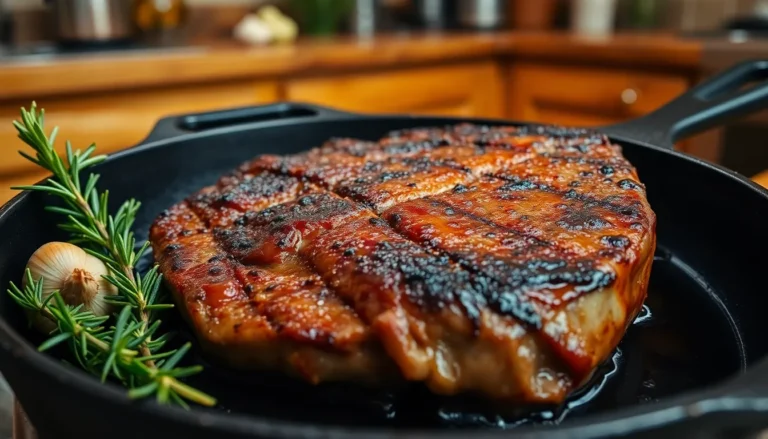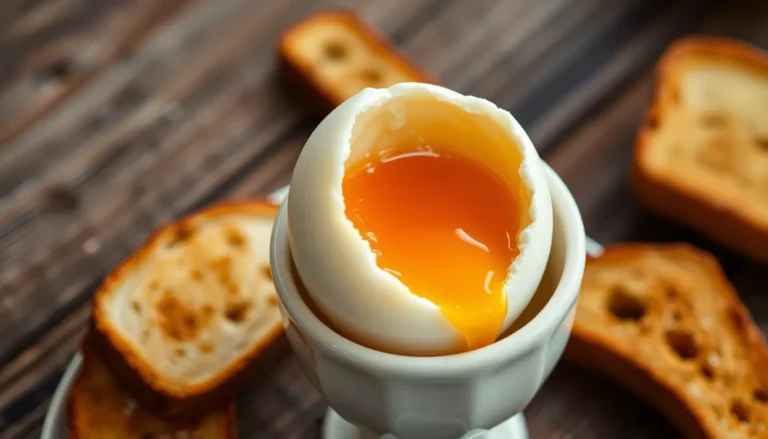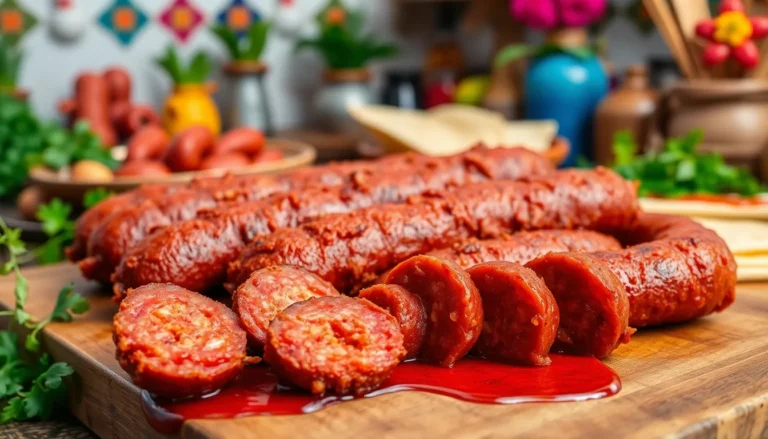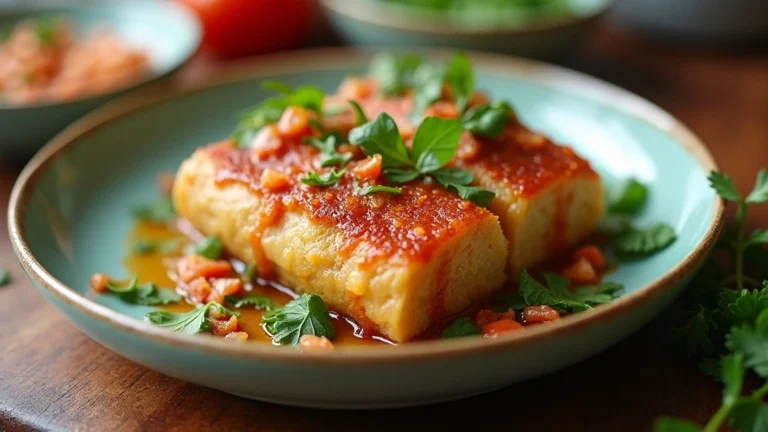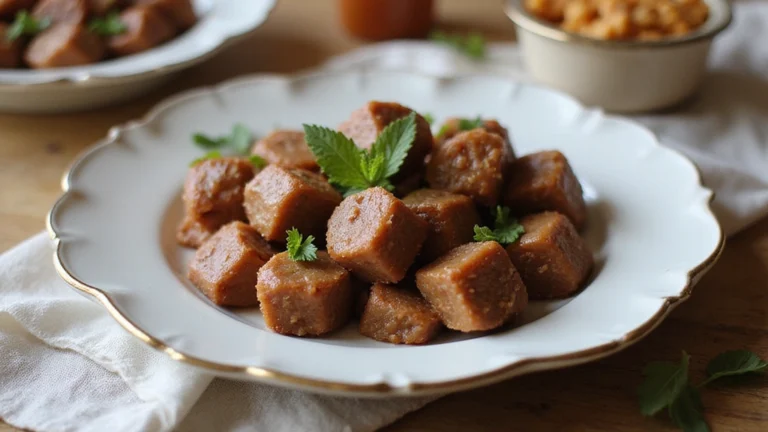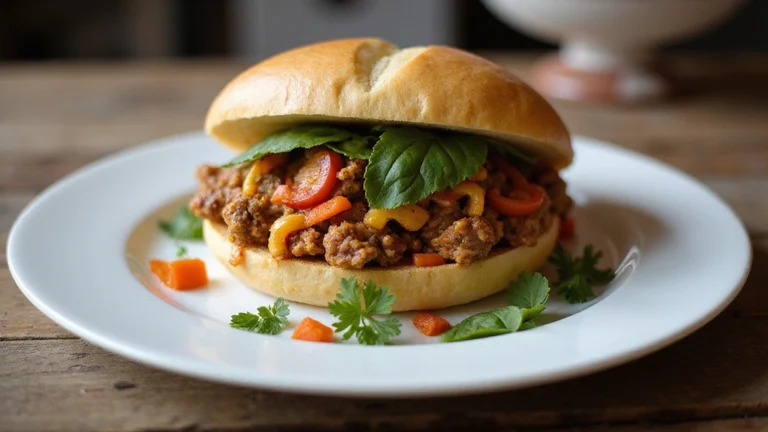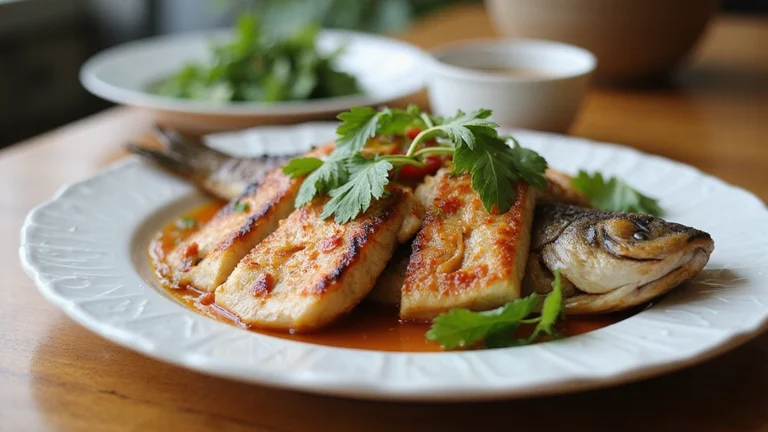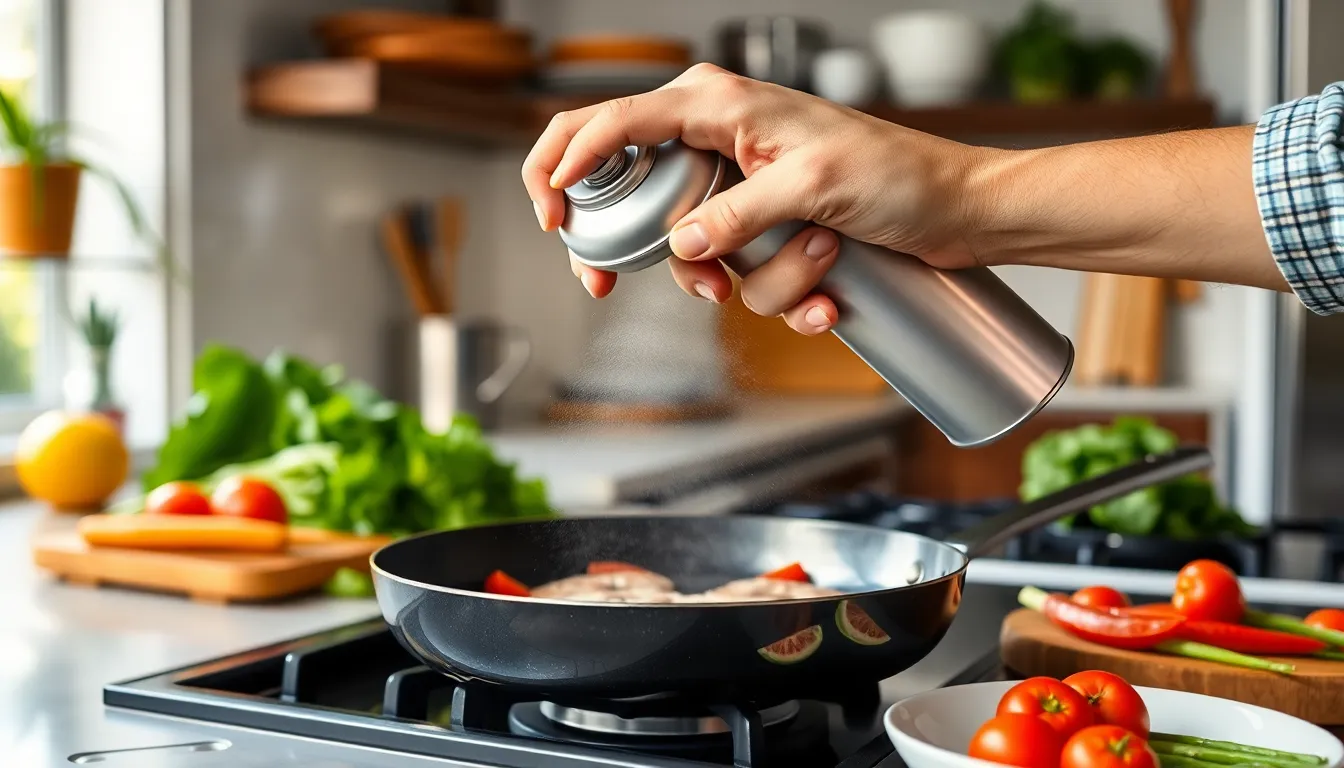
Wondering what’s cooking spray and why it’s become a kitchen essential? This miracle mist has revolutionized the way we cook, bake, and grill by providing a convenient alternative to traditional oils and butter.
Cooking spray is essentially oil in aerosol form, designed to create a non-stick coating on your cookware with minimal calories. You’ll find various types on store shelves—from classic vegetable oil versions to specialized varieties like olive oil, butter-flavored, and even flour-infused options for baking. Whether you’re looking to cut calories, achieve perfect release from pans, or simply make cleanup easier, this pantry staple delivers remarkable versatility with just a quick spritz.
What Is Cooking Spray?
Cooking spray is an aerosol product that delivers a fine mist of oil to cooking surfaces. It’s designed to prevent food from sticking while using significantly less fat than traditional greasing methods like butter or liquid oils.
Key Ingredients in Cooking Spray
Cooking sprays typically contain three main components that work together to create their unique properties. Oil forms the primary ingredient, usually in the form of vegetable oil, canola oil, olive oil, or coconut oil depending on the brand and intended use. Lecithin, an emulsifier derived from soybeans or eggs, helps the oil spread evenly across cooking surfaces for consistent coverage. Propellants like propane and butane (which evaporate immediately upon spraying) create the aerosol effect that transforms the liquid oil into a fine mist.
Many brands add specialized ingredients to create different varieties of cooking spray. Butter-flavored versions include natural or artificial butter flavor compounds. Flour-infused baking sprays combine oil with fine flour particles for more effective release when baking cakes and pastries. Some premium sprays incorporate additional antioxidants or vitamins to enhance nutritional value.
How Cooking Spray Works
Cooking spray relies on pressure and propellant technology to deliver a thin, even layer of oil. When you press the nozzle, pressurized propellant forces the oil mixture through a small opening, creating a fine mist of tiny droplets. These microscopic oil particles distribute evenly across cooking surfaces, requiring only about 1-2 calories per quarter-second spray compared to 120 calories in a tablespoon of traditional oil.
The lecithin in cooking spray plays a crucial role in its functionality. This emulsifier reduces surface tension and helps the oil form a temporary barrier between your food and the cooking surface. The cooking spray’s molecules bond to the microscopic pores and ridges of pans and bakeware, creating a slippery interface that prevents proteins and starches from adhering. Many professional chefs prefer cooking spray for delicate items like omelets and fish because it creates minimal interference with food texture while providing reliable non-stick performance.
Benefits of Using Cooking Spray
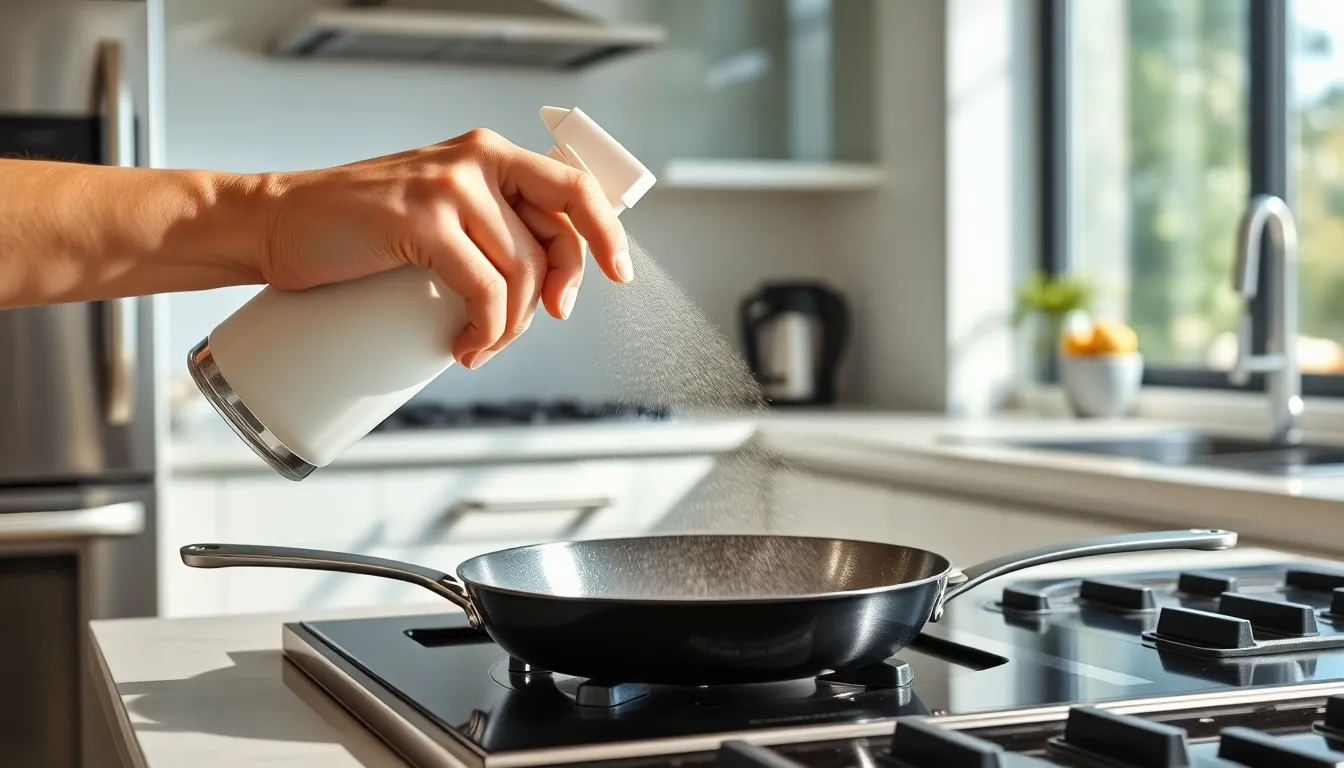
Cooking spray offers many advantages that make it a staple in modern kitchens. From health benefits to practical applications, here’s why cooking spray deserves a spot in your pantry.
Reduced Calorie and Fat Content
Cooking spray delivers significantly fewer calories and fat compared to traditional cooking oils. A typical spritz contains a fraction of the calories found in a tablespoon of oil or butter, making it an excellent choice for health-conscious cooking. Many cooking sprays in the US are labeled as “zero-calorie” because their serving size falls below the threshold requiring calorie disclosure. This calorie reduction doesn’t compromise your cooking results but can make a substantial difference in your overall dietary intake, especially if you cook frequently.
Non-Stick Properties
The thin, even coating provided by cooking spray creates an effective barrier between food and cooking surfaces. This non-stick layer prevents eggs, pancakes, and other sticky foods from adhering to pans, eliminating frustrating cleanup sessions. Cooking spray’s uniform application ensures complete coverage of cooking surfaces, including corners and crevices that might be missed when using oil or butter. Beyond cookware, it’s extremely effective for coating measuring cups when working with sticky ingredients like honey or molasses, allowing these substances to slide out completely.
Versatility
Cooking spray adapts to many cooking methods and situations with ease. It’s perfect for greasing baking pans, coating grill grates before barbecuing, and preparing sheet pans for roasting vegetables. The precision spray application makes it ideal for air fryers, waffle irons, and other appliances where controlling oil amount is crucial. Cooking spray also works wonderfully for coating food directly, such as when preparing breaded items or preventing pasta from sticking together after cooking.
Health Benefits
Using cooking spray contributes to a heart-healthier diet by minimizing unnecessary fat consumption. The controlled application helps you avoid excessive oil use that often occurs when pouring from bottles. Many cooking sprays feature heart-healthy oils like olive, avocado, or canola, providing essential fatty acids without overwhelming amounts of fat. For those monitoring fat intake due to dietary restrictions or health conditions, cooking spray offers a practical way to enjoy flavorful foods with minimal added fat.
Types of Cooking Spray
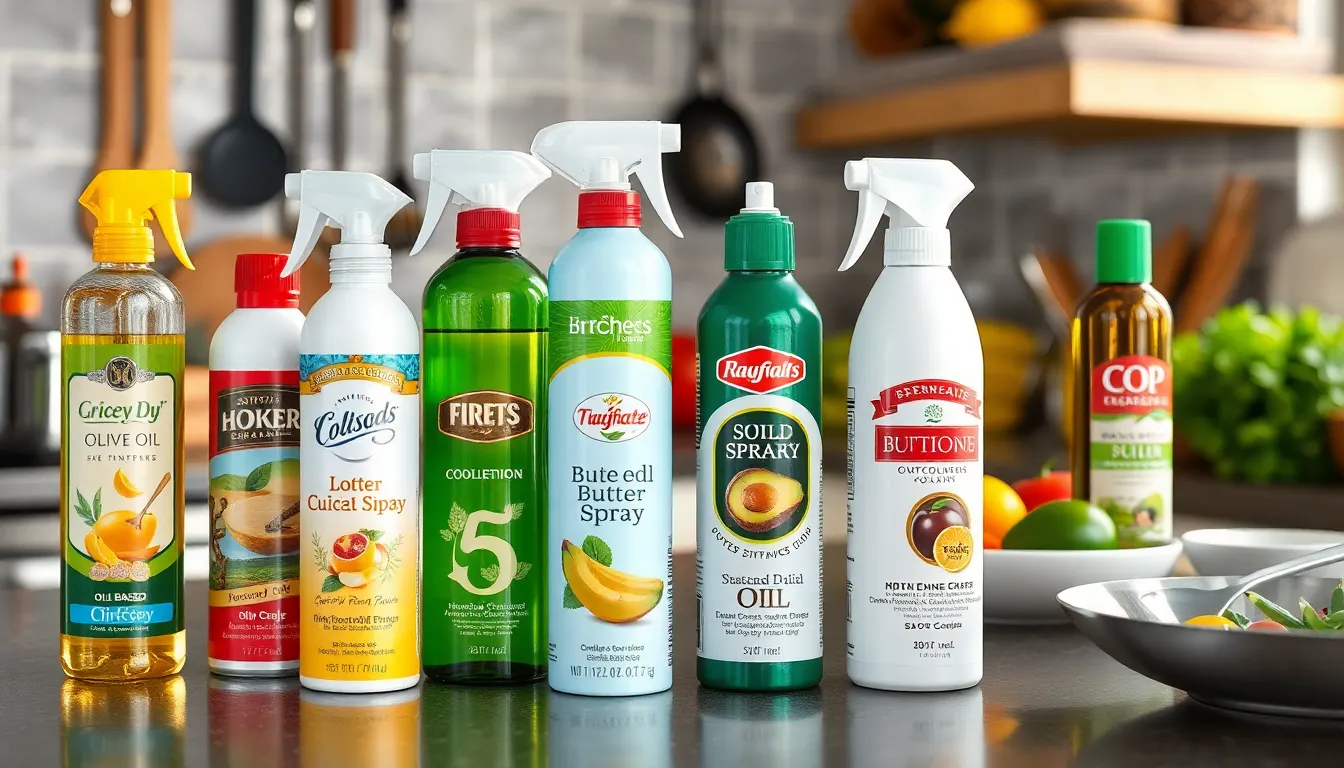
Cooking sprays come in several varieties to suit different cooking needs and dietary preferences. Each type offers unique benefits while maintaining the core function of preventing food from sticking to cookware.
Traditional Oil-Based Sprays
Traditional oil-based cooking sprays form the foundation of the market and represent the most commonly used varieties. These sprays typically contain vegetable oils like canola, sunflower, or soybean as their base ingredient. Popular brands such as Pam and Crisco dominate this segment, offering reliable non-stick performance for everyday cooking tasks. Traditional sprays feature a simple formula of oil combined with an emulsifier (usually soy lecithin) and a propellant to create the aerosol effect. Their neutral flavor profile makes them versatile for various cooking applications, from sautéing vegetables to baking cookies. You’ll find these sprays work effectively on most cookware surfaces, including non-stick pans, glass baking dishes, and stainless steel cookware.
Specialty and Flavored Varieties
Specialty and flavored cooking sprays have expanded the category beyond basic functionality to enhance cooking experiences. Olive oil sprays provide Mediterranean flavor notes while offering the heart-healthy benefits associated with olive oil. Butter-flavored varieties deliver the rich taste of butter without the high calorie content, containing as few as 2 to 5 calories per one-second spray. Avocado oil sprays cater to health-conscious cooks seeking high-heat cooking options with neutral flavor. Flour-infused baking sprays combine oil and flour for one-step pan preparation when making cakes and breads. Coconut oil sprays offer subtle tropical notes ideal for certain desserts and ethnic cuisines. Specialty options like organic, non-GMO, and propellant-free varieties address exact consumer preferences about ingredients and manufacturing processes. These enhanced formulations let you customize your cooking experience while maintaining the convenient, low-calorie benefits that make cooking spray popular in modern kitchens.
How to Use Cooking Spray Effectively
Cooking spray offers a convenient way to prevent food from sticking while using less oil than traditional methods. Applying it correctly ensures you get maximum benefit with minimal waste.
Best Cooking Applications
Cooking spray excels in multiple kitchen scenarios, making it a versatile tool for everyday cooking. Pan-frying, sautéing, and searing benefit from a light coating that creates a non-stick surface for meats and vegetables. Baking becomes easier when you spray cake pans, muffin tins, and bread pans, allowing baked goods to release cleanly without tearing. Grilling and roasting improve when cooking spray is applied to grates and roasting racks, preventing food from sticking and tearing during cooking. Additional creative uses include spraying food processor blades before chopping sticky ingredients, coating measuring cups before adding honey or molasses, and lightly misting Tupperware containers before storing foods prone to sticking.
Common Mistakes to Avoid
Over-spraying ranks as the most frequent error when using cooking spray, creating excessive oil buildup that leads to smoke, residue, and wasted product. Temperature limitations matter—standard cooking sprays aren’t designed for high-heat cooking applications, so opt for sprays specifically formulated for high-temperature cooking when grilling or frying. Non-stick cookware requires special consideration since excessive oil application can actually degrade the special coating over time. Label awareness is essential—choose sprays with natural ingredients and minimal additives for the healthiest cooking experience. For optimal results, hold the can upright about 6 inches away from your cooking surface and apply a thin, even layer with a quick spray motion, focusing on areas where food typically sticks.
Health and Safety Considerations
Cooking sprays are generally considered safe for consumption by the FDA, with their ingredients classified as Generally Regarded as Safe (GRAS). The thin layer of oil applied through these aerosol products provides significantly fewer calories than traditional oils while maintaining effectiveness.
Potential Concerns
Many consumers express hesitation about certain components in commercial cooking sprays. Additives like soy lecithin may trigger allergic reactions in sensitive individuals. People with soy allergies should carefully check ingredient labels before purchasing cooking sprays containing this emulsifier.
Propellants used in aerosol cooking sprays—typically butane, propane, or carbon dioxide—cause concern for some health-conscious cooks. These gases dissipate almost immediately after spraying, posing minimal health risks according to FDA assessments. The propellants don’t remain on cooking surfaces or in food in any important amount once the spray settles.
Alternatives to Commercial Cooking Spray
Creating homemade cooking spray offers complete control over ingredients. Fill a mister or spray bottle with your preferred oil—olive, avocado, or canola—for a simple alternative without additives or propellants. This option works particularly well for those with exact dietary restrictions or preferences.
Single oil commercial sprays have emerged as a market response to consumer concerns. These products contain just one type of oil without emulsifiers or propellants, appealing to those seeking simplicity in their cooking products.
Traditional greasing methods remain effective alternatives to cooking spray. Applying butter, shortening, or oils directly to cookware using paper towels, pastry brushes, or your fingers provides reliable non-stick results. These methods offer precise control over the amount of fat used, though they typically apply more oil than aerosol sprays.
Conclusion
Cooking spray has revolutionized modern kitchens by offering a convenient low-calorie alternative to traditional oils and fats. With just a quick spritz you can achieve non-stick perfection while cutting unnecessary calories from your meals.
Whether you choose traditional vegetable oil varieties or specialty options like olive oil and butter-flavored sprays you’ll enjoy easier cleanup and better food release. Remember to apply with proper technique to avoid residue buildup and protect your cookware.
For those with dietary restrictions or ingredient concerns homemade alternatives provide complete control while maintaining the benefits that make cooking spray so popular. From baking perfect cakes to grilling delicate fish cooking spray remains an invaluable tool that balances health consciousness with culinary convenience.
Frequently Asked Questions
What is cooking spray and how does it work?
Cooking spray is an aerosol product that delivers a fine mist of oil to cooking surfaces. It works by using pressure and propellants to create a thin, even layer of oil that bonds to pans and other surfaces, preventing food from sticking. This technology allows you to use significantly less fat than traditional greasing methods while still achieving excellent non-stick results.
What are the main ingredients in cooking spray?
Cooking spray typically contains three main components: oil (such as canola, vegetable, or olive oil), lecithin (an emulsifier that helps distribute the oil evenly), and propellants (usually propane and butane) that create the spray effect. Specialized varieties may include additional ingredients like butter flavoring or flour for specific cooking applications.
Are cooking sprays really “zero-calorie”?
Many cooking sprays are labeled “zero-calorie” due to their extremely small serving size (often just 1/3 second spray), which contains fewer than 5 calories, allowing manufacturers to round down to zero. In reality, cooking sprays do contain calories from oil, but the amount used is significantly less than traditional oils or butter, making them a lower-calorie alternative.
What types of cooking sprays are available?
Cooking sprays come in two main categories: traditional oil-based sprays (like Pam and Crisco) and specialty/flavored varieties. Options include vegetable oil, olive oil, canola oil, butter-flavored, avocado oil, and flour-infused sprays. This variety allows you to choose based on flavor preferences, health considerations, and specific cooking applications.
Is cooking spray safe to use?
Yes, cooking sprays are generally considered safe for consumption. The FDA classifies their ingredients as Generally Regarded as Safe (GRAS). The propellants used in aerosol cooking sprays dissipate quickly and pose minimal health risks. However, people with specific allergies (particularly to soy lecithin) should check ingredient labels carefully.
How should I properly apply cooking spray?
Hold the can 6-8 inches from the cooking surface and spray in a sweeping motion for even coverage. Avoid over-spraying, which can cause residue buildup and smoking. Apply before heating the cooking surface for best results, and be mindful when using around open flames. Different cooking methods may require adjustments to the amount used.
Can cooking spray damage non-stick cookware?
Excessive use of cooking spray can potentially damage non-stick cookware over time. The lecithin in many sprays can build up and create a sticky residue that’s difficult to remove and may degrade the non-stick coating. For non-stick pans, consider using minimal amounts or switching to oil applied with a paper towel or silicone brush.
What are alternatives to commercial cooking spray?
Alternatives include homemade cooking spray (oil in a mister bottle), single-oil commercial sprays without emulsifiers or propellants, and traditional greasing methods using butter, oil, or shortening. Silicone brushes can help apply minimal amounts of oil evenly. Parchment paper or silicone baking mats also provide non-stick surfaces without added fats.
